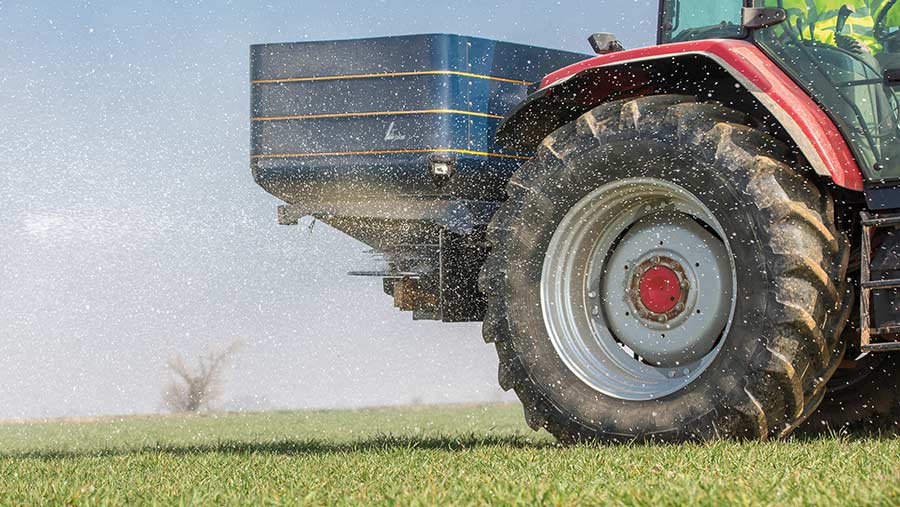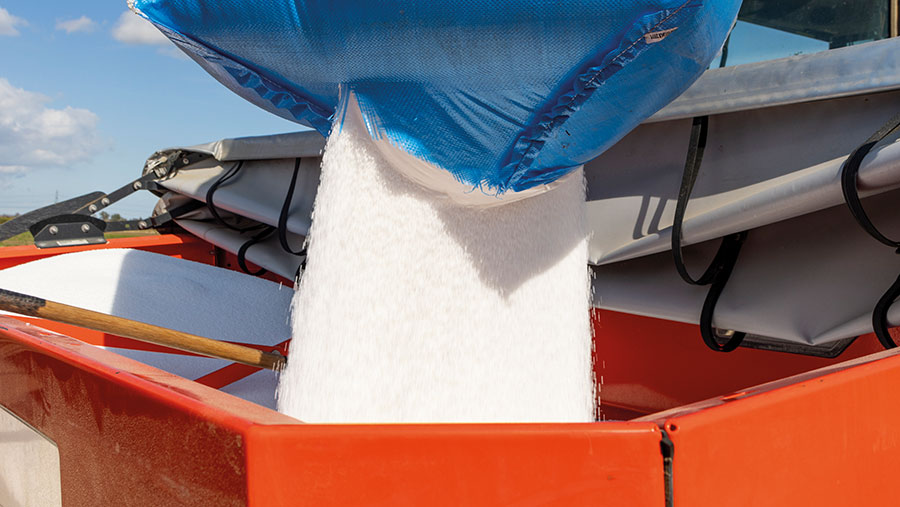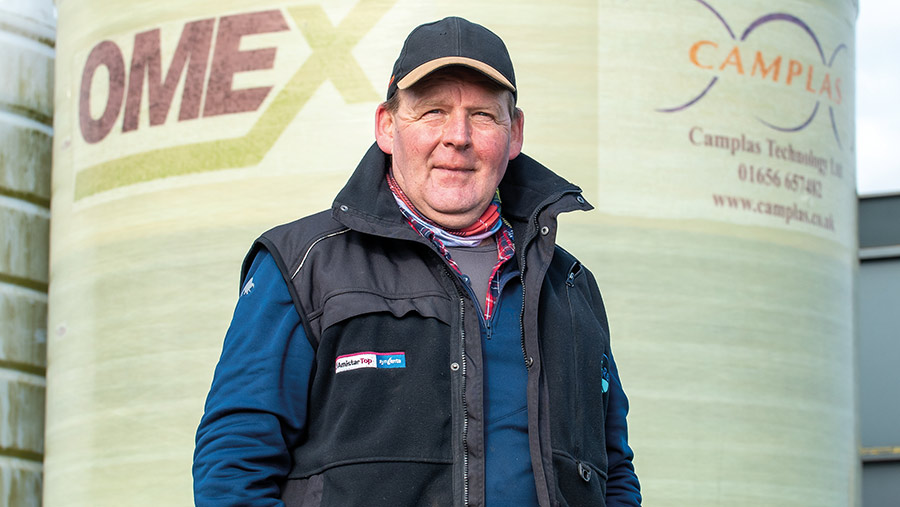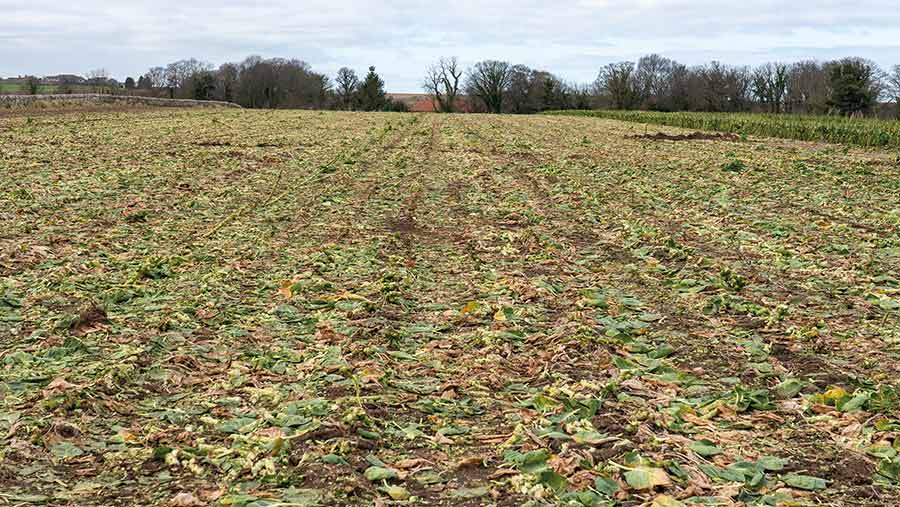How to reduce nitrogen fertiliser costs and emissions
 © Gary Naylor
© Gary Naylor High prices, supply chain issues and environmental concerns are prompting more farmers to reassess their fertiliser strategy.
Nitrogen fertiliser is the biggest source of greenhouse gas (GHG) emissions from agriculture, making it an increasingly high-profile environmental and political topic – and an issue farmers have been tasked with addressing.
Most emissions arise when nitrogen fertiliser is applied.
The biological processes of nitrification and denitrification in the soil after application cause the emission of nitrous oxide – a long-lived gas with high global-warming potential.
While keen to reduce nitrogen emissions, growers such as Transition Farmer Alan Steven (see case study below) are also demanding better value for money from fertiliser – including more accurate and efficient nutrient applications.
Mr Steven farms 138ha of premium land with his brother John and cousins at Kingsbarns, near St Andrews, Fife.
He grows premium crops – a mix of potatoes, field-scale vegetables and cereals – on a seven-year rotation for local markets.
“We moved to liquid fertiliser from solid for better compound placement on our potatoes,” says Mr Steven.
“It’s made it easier for us to deliver the right amount of nutrients where they are needed more accurately.”
Price spikes
Omex Agriculture commercial director Rob Burton says the company is receiving similar enquiries from other farmers looking to make the switch to liquid fertiliser – especially since last year’s nitrogen price spikes.
“More growers are wanting to get the best out of their fertiliser and improve their nitrogen use efficiency,” he says.
“They want to apply nutrients to the crop exactly where needed – and not beyond.”
There are other reasons growers consider switching, says Mr Burton.
Liquid fertiliser is popular with cost-conscious growers because it is applied by sprayer – making good use of existing farm machinery rather than having to buy a spreader.
“You know every square metre on the field is getting exactly the right amount of nitrogen, particularly round the field-edge.
“And nitrogen use efficiency [NUE] is improved too because being in the solution form it goes straight into the soil.”
Farmers who want to reduce nitrous oxide emissions from fertiliser need to understand and baseline their NUE, which shows how much nitrogen is being used by their farming system.
In its simplest form, NUE is a measure of the amount of nitrogen taken up by a crop compared to the amount of available nitrogen.
Armed with this information, growers can reduce any wastage and move closer to achieving net zero targets.
Average NUE levels are approximately 65% in the UK, giving plenty of scope for improvement, according to the findings from a recent trial undertaken on behalf of Kellogg’s.
In-season monitoring – using soil nitrogen supply (SNS analysis, tissue testing and handheld chlorophyll meters – showed a marked improvement in NUE to at least 72%.
Using the growing plant as a sensor worked well, improving NUE and reducing demand for fertiliser.
This is good for farm productivity, as well as for the environment – especially at a time when high levels of ag-inflation mean crop nutrition is expensive and commodity prices have eased back from last year’s highs.
Energy intensive
“Fertiliser is an essential component of crop production,” says Mr Burton.
“Nitrogen is probably responsible for 50% of the yield in most crops. So it is important to get the best out of it – whatever form you use – and make sure you know exactly what you’re doing and where it is going.”
As well as emissions arising from application and usage, some 50% of the GHGs associated with nitrogen fertiliser come from the production process itself, which is extremely energy intensive.
While manufacturing plants have significantly reduced any leakage from their facilities, the Haber-Bosch process used in nitrogen fertiliser production has seen little change over the past 100 years and comes with a large carbon footprint.
This process fixes atmospheric nitrogen with hydrogen to produce ammonia, the building block for all nitrogen products.
Under scrutiny, manufacturers and distributors are rising to the challenge of decarbonising their products.
Hutchinsons nutrition expert Tim Kerr says: “Prices may have fallen from 2022’s highs, but there is still a drive to optimise nitrogen rates linked to the broader recognition that nitrogen fertilisers are the largest contributors to the carbon footprint of crops.
We’ve invested in extensive trials across our regional technology centres and Helix farms, looking at possible solutions and ways to address nitrogen use by optimising soil health and the use of organic manures, cover cropping, and other alternatives.
Foliar applications of nitrogen in the form of methylated ureas can reduce nitrogen rates by about 30kg/ha, with no detrimental impact on yield, says Mr Kerr.
“This is all useful and shows that new technologies can help reduce our reliance on bagged nitrogen.”
Hutchinsons is currently evaluating a new product called R-leaf.
It uses photocatalysis to capture air pollution and turn it into nitrogen fertiliser.
It works by using daylight to enable the breakdown of nitrous oxides to nitrate that plants can take up as feed.
“R-leaf could offer a step forward in helping farmers reduce synthetic nitrogen use and increase profitability – a win-win,” says Mr Kerr.
“There are also ‘softer’ benefits to consider such as to the soils, as less synthetic nitrogen is applied.”
Make the most of nitrogen
1. Match nitrogen to crop requirements
Start by estimating soil nitrogen supply (SNS). This will give an indication of the soil’s capacity to supply nitrogen to a crop, based on previous cropping and fertiliser use, as well as soil type and winter rainfall.
2. Improve fertiliser timing
The timing of fertiliser applications is important for two reasons – maximising crop uptake and avoiding extreme weather events.
Apply nutrients as close to the time that the plants need them by splitting applications and keep an eye on the weather forecast.
3. Monitor the temperature
Avoid applications made in conditions that increase emissions.
Nitrogen uptake is restricted in cold temperatures, and soil needs to be above 10C for it to work well.
Urea is more prone to losses in windy weather.
4. Tailor applications
Knowing the yield potential of the site allows fertiliser applications to be tailored according to crop potential.
In addition, precision farming techniques can help target fertilisers according to need, preventing over-application while maintaining productivity.
5. Incorporate manures
The form that the nutrients are applied to a crop has a big impact on emissions.
For example, rapid incorporation of manures and organic materials prior to crop establishment will help reduce emissions levels.
6. Improve soil health
Soil acidity, organic matter content and structure will influence what happens to the nitrogen in the fertiliser once it is applied. Waterlogged soils produce higher emissions.
Fewer inputs
Crop nutrition expert ICL says reducing GHG emissions while producing more food with fewer inputs is the major challenge faced by UK farmers.
It specialises in controlled release, foliar and fertigation fertilisers.
The company also supplies phosphate, potash and polysulphate-based fertiliser – a product which can boost autumn establishment and root development, leading to higher yields at harvest.
“Understanding your soil is critical for optimising nutrient uptake,” says ICL agronomist Scott Garnett.
“Sulphur is essential for NUE, along with potassium and phosphate. If your soil is deficient, inevitably there will be a limiting factor and impact on yield.”
A 100kg/ha application of polysulphate resulted in a 28% increase in nitrogen uptake and a 41% increase in phosphate, during winter barley trials in 2020-21.
This was a significant increase in the efficiency for all key elements during the autumn period. Results were observed in the crop as stronger, healthier plants with a significantly enhanced biomass.
Plants that entered the dormant winter period in a healthy state then emerged faster and stronger when spring growth commenced.
Meanwhile, manufacturers such as Yara are investigating new techniques to produce “green” fertilisers that the company claims have a carbon footprint that is 80-90% lower than fertilisers produced with natural gas.
These fertilisers are still nitrate-based and have the same chemical and physical composition as their current product range; the difference is that the ammonia used in their manufacture is produced using hydrogen from water.
They will be produced in Norway, where the company’s first production plant is based, says Yara’s vice-president of green and low carbon fertiliser solutions, Birgitte Holter.
“Production of fertilisers without the use of fossil fuels will start in the second half of 2023,” she says.
CF Fertilisers has also made steps to reduce the emissions associated with its products and help farmers on their net-zero journey.
Abatement technology on the nitric acid plants, at its Billingham facility, has reduced emissions associated with Nitram by 40%.
To decarbonise its manufacturing process, CF Fertilisers is pursuing green and blue ammonia production.
Produced conventionally, but with the carbon dioxide captured and sequestered, it expects blue ammonia to be the more cost effective of the two.

© Gary Naylor
CCm Technologies is also assessing ways its fertiliser products – made with captured carbon dioxide and biological waste materials – can meet the crop’s nutrient demands while reducing the farm’s carbon footprint.
By taking the stabilising nutrients contained in already available resources, such as straw, woodchip and vegetable waste, CCm says the resulting fertiliser is then delivered to the crop in a readily available form.
Transition Farmer Alan Steven
Alan Steven switched to liquid fertiliser seven years ago, and says the advantages far outweigh any downsides.
He farms a seven-year rotation of potatoes, field-scale vegetables and cereals with his brother John and cousins on a mix of loam soils across 138ha at Kingsbarns, near St Andrews, Fife.

© Angus Findlay
“At the time, we happened to buy a second-hand planter,” explains Mr Steven, who says his main motivation was being able to adjust fertiliser application rates more easily on the potato crop.
“It came with a liquid fertiliser kit, which made it easier for us to make the change.
“Our intention was that we could link applications to soil maps, so we could deliver the right amount of nutrients where they were needed, more accurately.
“Our old granular fertiliser spreader was chain-driven. Upgrading it would have meant buying a new hopper for about £10,000 to do the same job.
“We looked at it and felt liquid fertiliser would work better on our variable soils – and would be more accurate, too.”
Operator safety was also a factor.
“Liquid fertiliser is much easier to handle than granular. There are no heavy bags and it’s stored outside in tanks, so you don’t need so much indoor shed storage. You just pull up to the tank and fill up.”
Mr Steven finds liquid fertiliser more efficient and productive.
One simple bowser is enough to keep planting potatoes throughout the day, and it does other jobs as well. But there are one or two downsides.
“Liquid fertiliser is a heavy product, so you need to be careful with soil compaction when you’re applying it. It’s a bit heavier on the sprayer, too.
“You get about 800 litres of fertiliser to the tonne compared to 1,000 litres of water, so it is slightly heavier.”
There are also different storage guidelines. Storage tanks are bunded for environmental protection in the event of a leak and to ensure the highest level of safety and security for the farmer.
Tanks need to be regularly inspected and maintained. But it is worth the effort, says Mr Steven.
“The big advantage is the accuracy of application – you’re never going to get better.
“It is easier to apply accurately to the crop while keeping it away from field boundaries and watercourses.”
Many benefits offered by cover crops
Cover crops offer benefits for soils, water quality, biodiversity and the farm business.
When it comes to reducing the need to apply nitrogen to following crops, two of the most common queries are how much N do they take up and what happens to it.
Various studies suggest that 10-50% of the nitrogen taken up by a cover crop will be available to the subsequent crop – with the rest having a crucial role in helping to build soil organic matter and improve soil function.
Adas trials indicate that many cover crops provide about 50kg of N/ha in the spring – which is worth good money in the current volatile fertiliser market.
According to work by Frontier Agriculture, cover crops are responsible for an average 60% reduction in nitrate leaching, and even better results can be achieved when they are established early.
Their ability to capture nutrients means they create plant material that is then returned to the soils following their destruction, and the nutrients are returned to the soil as organic matter.
Frontier’s specialist Rob Nightingale says the main driver of the amount of nitrogen taken up is the cover crop sowing date.
Crops sown in August have the opportunity for early rapid growth and the chance to develop a well-established rooting system.
“The longer they are in the ground, the more nutrient they will capture,” he adds. “In dry conditions, they will be less effective, as the nitrate doesn’t move as much.”
A freshweight cut down will help to understand how much nitrogen, phosphorus and potatssium has been captured.
He advises collecting a 1sq m sample of biomass from a representative area of the field and sending it away for analysis.
“This year, the results have shown a wide variation in nutrients, ranging between 30kg N/ha and 200kg of N/ha.
“This is influenced by factors such as soil type and previous cropping, as well as the species contained in the mix.”

© Angus Findlay
Avoiding losses to the atmosphere
Nitrogen in liquid fertiliser solutions of urea and ammonium nitrate is quickly available for crop uptake.
Solutions based on urea alone will contain no more than 18% nitrogen because at low ambient temperatures, urea crystallises out of solution, according to the RB209 guide published by the Agriculture and Horticulture Development Board.
Nitrogen content of applied urea lost to the atmosphere as ammonia varies, depending on soil and weather conditions, and is typically 10-30%.
Losses may be minimised if urea is applied shortly before rain is expected and/or is shallowly cultivated into the soil.
Recommended nitrogen rates are based on the main nitrogen source being ammonium nitrate, ammonium sulphate or calcium ammonium nitrate.
Urea can be treated with urease inhibitors to reduce losses through volatilisation.
If untreated urea is to be used, recommended rates may need to be adjusted to allow for losses as ammonia.
It is unlikely that this adjustment will be necessary if urea is treated with a urease inhibitor.
Nitrification inhibitors can delay the release of nitrate following fertiliser application, which can reduce leaching and nitrous oxide emissions.
They can be added to liquid fertilisers prior to application or sprayed onto soil prior to spreading solid fertilisers.
For complete agronomic advice on product choice and guidelines for use, consult a Facts-qualified adviser.
Urea fertiliser rules update
The introduction of new rules on urea fertiliser use will come into force later this year.
Defra farm minister Mark Spencer has warned farm leaders that, should they fail to meet this timescale, the government will intervene.
The original plan to only allow the use of untreated or unprotected urea products between 15 January and 31 March each year, with treated products used for the rest of the year, was due to be implemented by 2023.
That would have seen only protected fertilisers used at times of the year when the risks of ammonia emissions are at their highest.
The aim is to reduce the ammonia emissions associated with the use of urea and help the industry reach air quality targets.
However, unprecedented market conditions and product supply difficulties following the Ukraine invasion prompted Defra to delay the new regulations.
Mr Spencer has now made it clear that he wants sanctions in place from autumn 2023, with the industry scheme involving Red Tractor auditing.
With fertiliser prices reducing and availability issues easing, he stressed that he is not in favour of further delays.
Once under threat from a total ban, the use of urea fertiliser is still allowed under a self-regulation approach by the farming industry, although Defra will monitor progress and implement action if necessary.
Although the new scheme will be in place this autumn, inhibited urea will not be used in most situations until next spring.

